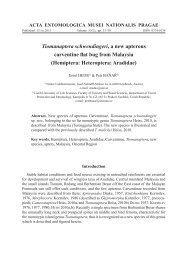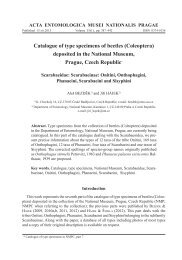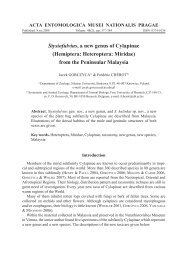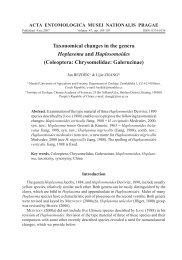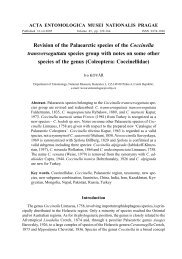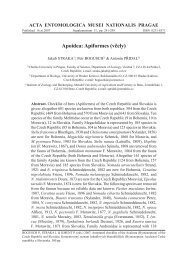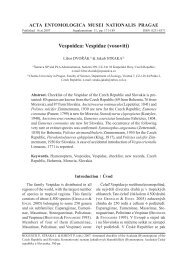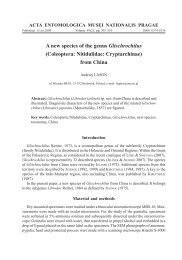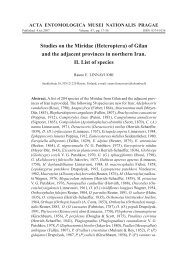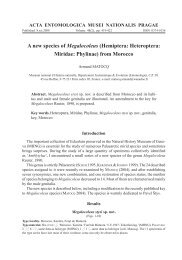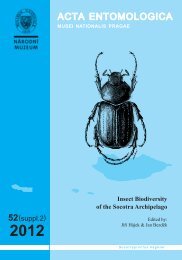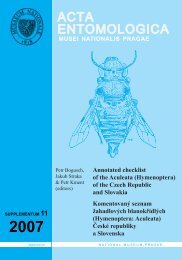Nomenclatural changes in the family Ciidae - Acta Entomologica ...
Nomenclatural changes in the family Ciidae - Acta Entomologica ...
Nomenclatural changes in the family Ciidae - Acta Entomologica ...
You also want an ePaper? Increase the reach of your titles
YUMPU automatically turns print PDFs into web optimized ePapers that Google loves.
138<br />
JELÍNEK: <strong>Nomenclatural</strong> <strong>changes</strong> <strong>in</strong> <strong>the</strong> <strong>family</strong> <strong>Ciidae</strong><br />
spond<strong>in</strong>g to <strong>the</strong> current <strong>family</strong> <strong>Ciidae</strong>. However, HERBST (1793) with some hesitation applied<br />
this name to a species which differed from <strong>the</strong> orig<strong>in</strong>al Fabrician description and which is<br />
now placed <strong>in</strong> <strong>the</strong> <strong>family</strong> Anobiidae. As demonstrated by MÜLLER et al. (2001), Herbst’s<br />
text is ra<strong>the</strong>r a mis<strong>in</strong>terpretation of <strong>the</strong> Fabrician taxon than a description of a new species,<br />
which would be <strong>in</strong> any case a junior primary homonym of Anobium nitidum Fabricius, 1792.<br />
Never<strong>the</strong>less, s<strong>in</strong>ce that time <strong>the</strong> name ‘nitidum’ has been applied <strong>in</strong> parallel to two different<br />
taxa, currently named as Cis nitidus (<strong>Ciidae</strong>) and Hemicoelus nitidus (Anobiidae). This<br />
duplicity was discovered already by PANZER (1793, Heft 10, no. 9), who wrote: ‘Da Hr.Prof.<br />
Fabric.[ius] Hr.Garn.[ison] Pr.[iest] Herbst und ich dieses Kaeferchen aus e<strong>in</strong>er Hand erhalten<br />
haben, und ich für die Richtigkeit der Fabriciuschen Bestimmung mir zu stellen getraue, so<br />
isst es wahrsche<strong>in</strong>lich, dass bey Hrn. Herbst e<strong>in</strong>e Verwechslung mit e<strong>in</strong>em andern Anobio<br />
vorgegangen seyn mag, welches er selbst vorläufi g zuzugeben geneigt sche<strong>in</strong>t’ [= As professor<br />
Fabricius, garrison priest Herbst and me received this beetle from <strong>the</strong> same source, and I am<br />
prepared to trust <strong>the</strong> identifi cation by Fabricius, it is probable that <strong>the</strong> confusion with ano<strong>the</strong>r<br />
Anobium may have been <strong>in</strong>itiated by Mr. Herbst, a situation that he himself has tentatively<br />
suggested might be <strong>the</strong> case]. It was repeatedly discussed by various authors (SCHILSKY 1900,<br />
MÜLLER et al. 2001) but no appropriate solution was adopted, perhaps because <strong>the</strong> location and<br />
identity of <strong>the</strong> true Fabrician types of <strong>Ciidae</strong> were not known. Most recent authors resolved<br />
<strong>the</strong> duplicity by attribut<strong>in</strong>g <strong>the</strong> name Anobium nitidum (Hemicoelus nitidus) to HERBST (1793)<br />
<strong>in</strong> spite of <strong>the</strong> alleged homonymy mentioned above. On <strong>the</strong> o<strong>the</strong>r hand, SILFVERBERG (1991),<br />
consider<strong>in</strong>g <strong>the</strong> specimen of ‘Anobium nitidum’ <strong>in</strong> <strong>the</strong> Fabricius collection <strong>in</strong> Copenhagen as<br />
<strong>the</strong> type specimen (see below), proposed <strong>the</strong> replacement name Cis alter Silfverberg, 1991,<br />
for ‘Cis nitidus auctt. non Fabricius’. Unfortunately, this name does not meet <strong>the</strong> conditions<br />
of ICZN Article 13 and is <strong>the</strong>refore unavailable (nomen nudum) as realized by ORLEDGE &<br />
BOOTH (2006).<br />
The specimen stand<strong>in</strong>g as ‘Anobium nitidum’ <strong>in</strong> <strong>the</strong> Fabricius collection <strong>in</strong> <strong>the</strong> Zoological<br />
Museum of <strong>the</strong> University, Copenhagen, is a fragment of an anobiid identifi ed as Anobium<br />
(A.) punctatum (DeGeer, 1774) by B. Buche, and apparently does not belong to <strong>the</strong> type<br />
series of Anobium nitidum (MARTIN <strong>in</strong> litt.; MÜLLER et al. 2001). I exam<strong>in</strong>ed two conspecifi c<br />
syntypes of Anobium nitidum Fabricius, 1792, deposited <strong>in</strong> <strong>the</strong> Museum of Natural History of<br />
<strong>the</strong> Humboldt University, Berl<strong>in</strong> (MÜLLER et al. 2001) <strong>in</strong> October 2006. One of <strong>the</strong>m lacks <strong>the</strong><br />
head and prothorax, but <strong>the</strong> second, apart from be<strong>in</strong>g faded out, is well preserved, with seriatepunctate<br />
elytra bear<strong>in</strong>g erect seriate setae, and with one completely preserved antenna of n<strong>in</strong>e<br />
antennomeres. This specimen is clearly conspecifi c with Sulcacis affi nis (Gyllenhal,1827).<br />
In order to stabilize <strong>the</strong> nomenclature, this latter specimen was designated as <strong>the</strong> lectotype<br />
of Anobium nitidum Fabricius, 1792, and appropriately labelled (see above). The identity of<br />
Anobium nitidum F. with Sulcacis affi nis is not <strong>in</strong> confl ict with <strong>the</strong> brief orig<strong>in</strong>al description<br />
of <strong>the</strong> former (black with testaceous legs).<br />
The history of <strong>the</strong> nom<strong>in</strong>al taxon Anobium nitidum Fabricius, 1792, was ra<strong>the</strong>r <strong>in</strong>tricated<br />
from <strong>the</strong> beg<strong>in</strong>n<strong>in</strong>g. Apart from <strong>the</strong> mis<strong>in</strong>terpretation by HERBST (1793), <strong>the</strong> current concept<br />
of Cis nitidus goes back to PANZER (1793), whose fi gure of Anobium nitidum F. seems to<br />
represent Cis nitidus <strong>in</strong> <strong>the</strong> current sense. In fact, <strong>the</strong> name Anobium nitidum Fabricius, 1792,<br />
is <strong>the</strong> oldest available name for Sulcacis affi nis (Gyllenhal,1827), while <strong>the</strong> oldest available



